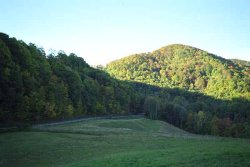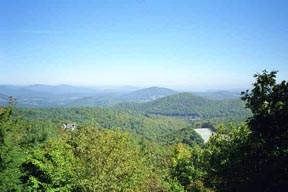A Country Rag Rustic Refrain
|
-- Ralph Waldo Emerson
|
|
THE APPALACHIAN TRAIL:
A How-To Guide
 I have been surprised at how many people cannot build a fire, but when you
think that most are born and raised in a city today, it is not surprising
that they would lack such a skill. Many of our young folks have never been
camping, unless it's in an R.V. park, or stepped foot on a farm, or grown a
garden (maybe a house plant or two). Fortunately for me, I have a lot of
experience in nature, including having hiked over 400 miles of the
Appalachian Trail to Tennessee's Smoky Mountains.
I have been surprised at how many people cannot build a fire, but when you
think that most are born and raised in a city today, it is not surprising
that they would lack such a skill. Many of our young folks have never been
camping, unless it's in an R.V. park, or stepped foot on a farm, or grown a
garden (maybe a house plant or two). Fortunately for me, I have a lot of
experience in nature, including having hiked over 400 miles of the
Appalachian Trail to Tennessee's Smoky Mountains.Generally speaking, you want to carry only what you need and nothing more to reduce weight, and double duty items are most precious. By double duty I mean items such as a five gallon bucket which serves not only as a water container for washing clothes, dishes, and your body, but also as a storage container for food and kitchen equipment when hiking. A bucket makes a very good chair when you need a place to sit too, and keeping food out of your pack means less critters like mice eating a hole in it at night to get to your food (and ruining your pack). As far as clothing goes, I recommend a combination of nylon and fleece, because they are synthetic and the fibers do not hold water (which will wick the heat away from your body when wet and make them take much longer to dry). I pack one pair of nylon shorts, one pair of nylon pants, one pair of fleece pants, two nylon shirts, one fleece shirt, and a nylon windbreaker. My total clothing weight is around three pounds and takes up very little room in my pack. Nylon and fleece don't absorb body odors either, so they are easy to clean and extremely durable (except to heat). By layering nylon and fleece, I can stay warm in even zero degree temperature. I do not use a conventional tent; instead, I use a plastic tarp with duct tape reinforced grommets because it is much lighter. I have a separate mosquito net that I can hang under my tarp to keep out insects if needed which is also very light. I use a nylon poncho for rain gear which also doubles as a ground cloth under my tarp. A 30 foot length of nylon rope, five aluminum tent pegs, and a couple of bungee cords, and you have a very light weight and durable shelter that only weighs a little over a pound. As far as cooking gear is concerned, I use a stainless steel pot with lid (it heats up water faster in winter if you use a lid), one spoon, one fork, my pocket knife, and an aluminum pot handle (to pick up the hot pot), and a stainless steel pan (which also doubles as a plate). I also have a fold up "toaster" and a French press for making toast and coffee. (The press also doubles as a drinking glass.) I either cook on an open fire or a propane stove depending on where I am and the weather. Walmart sells a very light weight propane stove top and a mini propane lantern that fits on one of the little propane bottles. All this goes in my bucket with my food. The nice thing about the bucket is you can carry a loaf of bread and a dozen eggs without crushing them (like would happen in a back-pack). Total weight of my kitchen gear and bucket is about five pounds (including the propane tank). Sleeping gear is a heavy duty sleeping bag in winter and a fleece bag liner (with zipper) in spring, summer, and fall. The bag liner is very light weight (a little over a pound) and the fleece clothing can be put on inside the bag if it gets a little too cold. Stuffing your extra clothing into a stuff bag makes a nice pillow, and I recommand a good air mattress like the "Therma-Rest." I have used mine hundreds of times and it still holds air as well as the day I bought it. The Therma-Rest is the heaviest piece of equipment I have, but is well worth it to sleep comfortably. One other piece of essential equipment is an aluminum tube about two feet long. It is used to blow on your fire coals to restore a dying fire as well as to develop a spring when you need water. If you try dipping water from a spring with a cup, you will stir up the sediment (which is where most of the organisms live). It is better to insert the tube into the pool of water and let the surplus water flow out the tub (and into your water bottle). Speaking of water bottles, I use what is called a "camel pack," which is an insulated bladder that fits inside your back-pack with a plastic tube connected from which you sip. Mine holds two quarts, which is usually adequate for a day's water supply. Try to camp near a water supply if possible.
Footwear is very important too. If you carry a heavy load, you will need a
good pair of hiking boots for ankle support. If you pack lightly like I do,
you can get by with a good pair of tennis shoes and a pair of light-weight
"rubbers" that slip over the shoes for wet times. I wear two pairs of nylon
socks with a pair of cotton socks between them, which greatly reduces the
friction of your foot against the shoes (and prevents blisters). Your
That pretty much covers all the equipment you will need to stay comfortable hiking and camping. I use an internal frame pack, which is more comfortable and smaller, and the total pack weight with food and water is around 35 pounds, and 40 pounds in winter with the heavier bag.
|

ANNOTATED LINK LISTINGS FOR APPALACHIA AND THE TRAIL |
Go to:
Word Preserve
A Country Rag Index
İRay Arrowood, 1999. All rights reserved.
 cotton socks will not wear out as fast either. There is nothing worse than
hiking with blisters on your feet!
cotton socks will not wear out as fast either. There is nothing worse than
hiking with blisters on your feet!